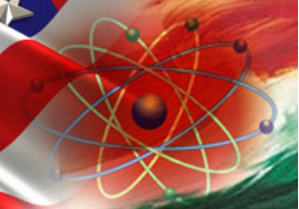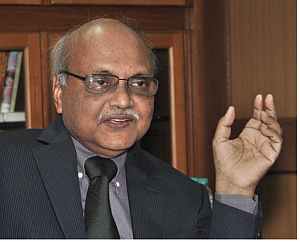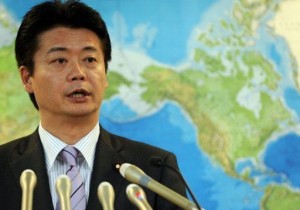Update on India's civilian nuclear energy program
The nation continues to chart an independent course
By Dan Yurman
 According to research compiled by the World Nuclear Association, India expects to have 20 GWe nuclear capacity on line by 2020 and 63 GWe by 2032.
According to research compiled by the World Nuclear Association, India expects to have 20 GWe nuclear capacity on line by 2020 and 63 GWe by 2032.
It aims to supply 25 percent of electricity from nuclear power by 2050. That's an ambitious program. Getting there won't be easy.
Whether or not U.S. firms, including small modular reactor vendors, will have any access to the Indian market remains an open question. Here are a few updates about progress, and setbacks, along the way.
First fuel loading at Kundankulam
Despite eight months of tumultuous anti-nuclear protests in India, in March the provincial government of Tamil Nadu came out in favor of starting the two Russian built 1000-MW VVER reactors at Kudankulam. Local government officials weighed in on the side of alleviating chronic electricity shortages in the region.
This week, India's Atomic Energy Regulatory Board gave its approval for loading real fuel in the first unit. Following a 20-day startup period, the reactor will achieve criticality and begin generating electricity on the grid.
Indian Minister of State V. Narayanasmay, in the prime minister's office, said that the decision for hot start was made following a special review by an independent team of 13 scientists and engineers.
The second nuclear unit is nearing completion. Narayanasmay said that 95 percent of the work is done and that the reactor could be commissioned later this year.
NPCIL to proceed with Kovvada plant
With ducks in a row at Kundankulam, Nuclear Power of India Limited (NPCIL) is planning to move ahead with development of a 10-GWe power station at Kovvada Matsyalasem in Ranasthalam. Construction of the first two units could start as early as 2014.
Indian government authorities have learned a thing or two from the protests at Kudankulam and also Jaitapur. At Kovvada, they are working hard to address land compensation issues for displaced farmers. This has turned out to be a crucial issue to promote local acceptance of the power stations.
Aluminum plant drives demand for new reactors
The completion of two 700-MW indigenous design PHWR reactors at the Kakarapar Atomic Power Station in Gujarat is the basis for a new collaboration between NPCIL and Nalco, the state-owned aluminum company. The two units under construction are a joint venture and the two firms are now in talks for a new round of reactors.
If the new deal goes through, NPCIL would have a 51-percent stake and Nalco a 49-percent stake. Options being considered include sites to support 1500-MW at West Bengal, Odisha, or Rajasthan.
Nalco's plan is to diversify to become an independent power producer. Its aluminum and other non-ferrous metal smelters consume huge amounts of electricity, hence its investments in current and new nuclear reactors.
Passing the torch
Ratan Kumar Sinha, director of the Bbabha Atomic Research Center (BARC), took over the first week of May as chairman of India's Atomic Energy Commission from Srikumar Banerjee, who retired after 45 years of service.
Sinha has worked extensively on advanced reactor designs as well as on development of small modular reactors for remote areas of India that are not connected to the national grid. He first joined BARC in 1973.
In response to questions from the Indian news media about protests at Kudankulam and Jaitapur, Sinha said, "My priority will be removing irrational fear about radiation from people's minds. Nuclear energy will have a larger role for India's growth."
He added that the benefits of electricity from nuclear energy will be power for economic development and desalinization processes to increase supplies of potable drinking water.
In a ceremony marking the changing of the guard, Banerjee said that India could now deliver its 700-MW PHWR reactors at the equivalent of $1700/Kw. He said that by comparison, international vendors working on Indian projects were coming in at $3000/Kw for a 1000-MW unit.
Banerjee also said that Larson & Tubro would soon be making reactor pressure vessels at its Hazira plant.
He closed by saying that despite Fukushima fears that caused other nations to shut down their nuclear reactors, India is building more of them.
"After Fukushima, we received expressions of interest from Haryana, Rajasthan, and Madhya Pradesh to set up nuclear power plants. We will do all of them," Banerjee said.
U.S firms remain locked out of India's market
The landmark civil nuclear agreement signed in 2008 between the United States and India was supposed to open the door for U.S. firms to compete for up to $150 billion in new nuclear reactor business. It hasn't worked out that way. The two countries continue to have differences, expressed through diplomatic channels, over the issue of liability in the event of an accident.
A series of high-level consultations, including a direct discussion between U.S. President Obama and Indian Prime Minister Manmohan Singh last November, have yielded little progress on the subject. Since then, U.S. Secretary of State Hillary Clinton visited India to address the issue, but without effect.
So far, no U.S. firm is involved in any of the planned 39 new reactors (45 GWe) that are on the books.
In early May, U.S. Treasury Secretary Timothy Geithner met with Indian Finance Minister Pranab Mukherjee in Washington, DC, to complain about "dampened enthusiasm" by U.S. firms related to India's investment climate.
Ron Somers, a spokesman for the U.S. India Business Council, complained publicaly at the time of the Mukherjee's visit by saying that "it is harder to do business there," referring to restrictions that the Indian government has put on U.S. firms trying to enter its markets.
Somers warned about protectionist actions by several provincial governments favoring local manufacturing of electronics and their failure to protect patents by allowing generic manufacturing of pharmaceuticals.
In addition to the nuclear liability issue, India has raised issues with the United States about reprocessing spent nuclear fuel and whether U.S. firms can have the lead in an equity relationship with NPCIL for any new reactor sites. All of these actions add up to a continuing lock out of U.S. firms from India's civilian nuclear energy markets.
Liability law a two-edged saw
It appears U.S. firms are not alone in their concerns about India's nuclear liability law. Indian vendors providing components for new nuclear reactors to NPCIL have privately complained that insurance companies are now denying the coverage because of it.
The Federation of Indian Chambers of Commerce (FICCI), speaking collectively on behalf of members, wrote a letter to the prime minister's office in early May saying that the law places them in jeopardy of "unlimited liability."
FICCI said that it wants a turnover of liability to the reactor operators-NPCIL and its equity partners-for components five years after installation.
Japan sets conditions for nuclear technology
Japan's heavy industries, including Hitachi and Mitsubishi, have marketing strategies that cover penetration of India's civilian nuclear energy market estimated to be worth $150 billion over the next two decades.
India has indicated it wants access to Japan's nuclear energy expertise. If it sounds like a case of full speed ahead, wait, because there is a major pothole in the road.
Japan said on May 1 that it wants India to sign the Nuclear Non-proliferation Treaty (NPT). For its part, India has said that it feels its commitment to the principles of nonproliferation make the signature a non-event. Actually there are strategic reasons why India won't sign, which have to do with Pakistan-which also has not signed the NPT.
India's External Affairs Minister Pranab Mukherjee said during a visit to Tokyo in 2007, "If India did not sign the NPT, it is not because of its lack of commitment for non-proliferation, but because we consider NPT as a flawed treaty and it did not recognize the need for universal, non-discriminatory verification and treatment."
The issue of India's position on the NPT relative to Japan was kicked into high gear in early May by the visit of Koichiro Gemba, Japan's minister of Foreign Affairs, who met with India's Minister of External Affairs S.M. Krishna.
This isn't a new issue for either country. Japan wants to do business, but it also wants the formal NPT to guarantee that its technology won't be used for weapons work.
Gemba said that Japan wants India to sign the NPT as proof it will not engage in any further nuclear weapons testing. India isn't willing to make that commitment. Its future relations with the Nuclear Suppliers Group rests in part on how this issue is viewed by its members.
India needs Japanese nuclear technology and parts, especially reactor pressure vessels. While India is building a factory to make them, production is a few years away. In the meantime, Japan holds a virtual monopoly on these components through Japan Steel Works.
If the two countries can't work out their differences, it could impact not only India's construction of its 700-MW PHWRs, but also Areva EPRs. The Russians supply their own pressure vessels and would not be impacted by an impasse.
Singh reaffirms commitment to nuclear power
Prime Minister Manmohan Singh said May 14 there would be no compromise on safety of atomic plants and it would hurt the nation's economy to close the additional source of energy.
"It would be harmful for the country to pass an ordinance on denial of nuclear power," Singh said.
Singh was replying to a question in parliament on whether India would re-think its commitment to nuclear power in the post-Fukushima world in which Germany is closing its reactors and Japan has shut down its fleet for now.
"We must have nuclear power as an additional source of energy," Singh said.
He said there would be no compromise on the safety of nuclear power plants.
Singh said after the Fukushima accident of March 2011, he had ordered a complete review of all the 20 operating nuclear power reactors across the country and none of them has reported any incident.
India currently has 4 GWe of nuclear generated electricity.
__________________
Dan Yurman publishes Idaho Samizdat, a blog about nuclear energy and is a frequent contributor to ANS Nuclear Cafe.

-3 2x1.jpg)

